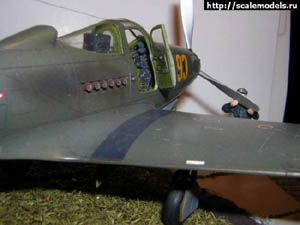
P-39Q-5-BE Airacobra of the deputy commander of 3 air squadron of 30
GvIAP (273 IAD 6 IAK 16 VA) -
senior lieutenant A.P.Filatov, Poland, autumn 1944
|
"The trump Cobra" of A. Filatov model, text and photos by Michael Neradkov http://scalemodels.ru/articles/26.html |
|
|
|

P-39Q-5-BE Airacobra of the deputy commander of 3 air squadron of 30
GvIAP (273 IAD 6 IAK 16 VA) -
senior lieutenant A.P.Filatov, Poland, autumn 1944
| Some notes on Filatov Aleksandr Pavlovich (1 April 1922 -??)
Unlike other combat pilots, he loved Russian literature and especially poetry. He was a modest man, that tried not to show himself proud of his victories to other people. When sitting down into the cockpit, he quietly listen at the report of mechanics, put on his parachute, showed no emotion, inspected attentively behind his shoulders and took off. Here his modesty disappeared: after completing 175 combat missions, he shot down 21 aircraft personally, and 4 shared in 35 air battles. He was shot down and was taken prisoner twice, but he escaped both times. The Airacobra of Filatov is very interesting because of its nose-art, uncommon for USSR VVS : three playing cards near the cab. |
The model
This model is built almost out of the box... but Profipacked box :-)
Eduard's Airacobras are widely known to modelers as remarkable kits,
there are no real competitors in1: 48 scale.
The kit includes not only the plastic parts, but also a photo-etch
sheet with fine details, painting masks and a small weight for the nose
section.
My model was assembled in what is called "on the flick", I had only
2 problems exclusively because of my own inaccuracy and inattention.
1) Regarding the wing panel lines. After studying several drawings, I came across a problem. On the Eduard kit, the lines on the upper part of the wings are partially similar to the drawings from D&S, but not completely. "War in Air" (used ML pictures), on them also is very similar the Yellow Series drawing, they do not coincide. Drawings from "In action" are generally similar. Because of this, the upper part of the wing was rescribed according to drawings from ML/"War in Air".
2) the presence on this machine of underwing machine gun pods. Only in the Eduard's instruction these guns are represented for this aircraft, on allthe other drawings of Filatov's Cobra they are absent, such as on 2 archive photos. However, I took a chance and installed them; being them easily removable and installable at the pilot's will, this version is likely all the same.
Painting
I've found 3 profiles of the machine Of A.P.Filatov and two archive
photographs.
Profiles can be found on
Finishing, decals, aging and weathering
After painting, the model was passed with a layer of Glanzer for a glossy
surface for a better adherence of the decals from the kit.
Eduard uses Cartograph decals (Italy) of excellent quality, they lay
practically without any problems, with a little help from MicroSol.
After a day of drying, an additional layer of Glanzer was applied.
The wash was done by artistic acryl manufactured in St. Petersburg:
brown on the underside and black-brown on the uppersurface of the plane.
Then a last layer was applied: semi-matt coating from the AKAN line.
By the way - this is the simply light-grey paint of a certain degree
of dullness.
Last primes - smokiness and "pant chip" to the metal layer, dry brushing
some elements.
For the antenna the "Hobby-plus" special thread proved to be a sufficiently
interesting material. Easily painted and glued, it possesses grow prettier
by tensibility, also possible to select the necessary thickness.
The technician are from the Alanger's kit, painted with St. Petersburg
artistic acryl paint.
The pedestal's basis was made by Plexiglas, then the earth was made
from soda & superglue, concrete runway from the cardboard and grass
from dill.
 |
 |
 |
 |
 |
|
 |
 |
 |
References: